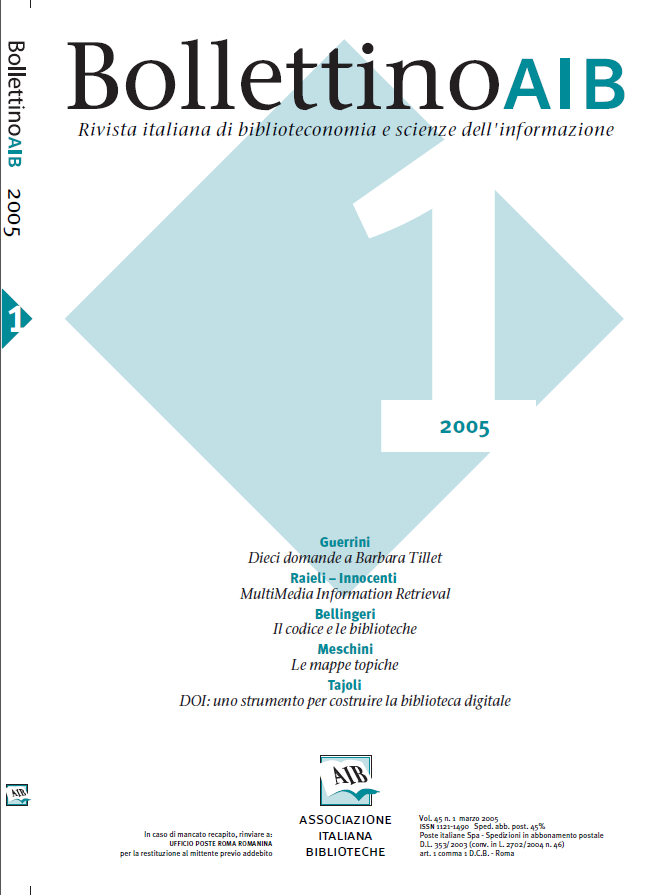DOI: uno strumento per costruire la biblioteca digitale
Contenuto principale dell'articolo
Abstract
Il Digital Object Identifier (DOI) nasce per soddisfare le esigenze degli editori per quanto riguarda gli oggetti digitali e la distribuzione via Internet d'opere protette dal copyright. La struttura interna del DOI è abbastanza semplice; una delle sue caratteristiche principali è di essere un numero opaco, senza un significato immediatamente rilevabile. La proposta iniziale venne dall'Association of American Publishers nel 1996.
Il DOI appare come una base comune che permette di connettere diversi identificativi come ISBN, ISSN, PII, SICI, ect. E' stato sottolineato con enfasi che il DOI non fu portato avanti dall'AAP ma da un'apposita fondazione, l'International DOI Foundation, nata nel 1998. La discussione sul DOI si sviluppò sopratutto tra il 1997 e il 2002, quando fu costruita l'infrastruttura di gestione. Vi erano anche esigenze di promozione. Si decise di usare l'architettura di per descrivere il set dei metadati collegati ad un DOI. Norman Paskin, il direttore of IDF, emerse
come il principale referente per il DOI. All'inizio la risoluzione di un DOI portava ad un unico oggetto digitale, in un rapporto 'uno ad uno'. Ma in realtà era necessaria una risoluzione 'uno a molti'. La soluzione giunse con i servizi offerti da CrossRef. Questo passaggio ha facilitato ulteriori sviluppi, come l'integrazione con lo standard OpenUrl.
Si suggerisce che un possibile concorrente per il DOI potrà essere l'identificativo OAI. Tuttavia esso è meno robusto del DOI. Il futuro sviluppo della situazione dipenderà dai servizi correlati agli identificativi e dalla diffusione degli open archives.
Il DOI appare come una base comune che permette di connettere diversi identificativi come ISBN, ISSN, PII, SICI, ect. E' stato sottolineato con enfasi che il DOI non fu portato avanti dall'AAP ma da un'apposita fondazione, l'International DOI Foundation, nata nel 1998. La discussione sul DOI si sviluppò sopratutto tra il 1997 e il 2002, quando fu costruita l'infrastruttura di gestione. Vi erano anche esigenze di promozione. Si decise di usare l'architettura di per descrivere il set dei metadati collegati ad un DOI. Norman Paskin, il direttore of IDF, emerse
come il principale referente per il DOI. All'inizio la risoluzione di un DOI portava ad un unico oggetto digitale, in un rapporto 'uno ad uno'. Ma in realtà era necessaria una risoluzione 'uno a molti'. La soluzione giunse con i servizi offerti da CrossRef. Questo passaggio ha facilitato ulteriori sviluppi, come l'integrazione con lo standard OpenUrl.
Si suggerisce che un possibile concorrente per il DOI potrà essere l'identificativo OAI. Tuttavia esso è meno robusto del DOI. Il futuro sviluppo della situazione dipenderà dai servizi correlati agli identificativi e dalla diffusione degli open archives.
Dettagli dell'articolo
Fascicolo
Sezione
Articoli

Questo lavoro è fornito con la licenza Creative Commons Attribuzione - Condividi allo stesso modo 4.0.
